If your child’s tooth has come out too soon because of decay or an accident, it is important to maintain the space to prevent future space loss and dental problems when permanent teeth begin to come in. Without the use of a space maintainer, the teeth that surround the open space can shift, impeding the permanent tooth’s eruption. When that happens, the need for orthodontic treatment may become greater.
Types of Space Maintainers
Space maintainers are made of stainless steel, and can be removable or fixed (cemented to the teeth).
Band-and-loop Maintainer
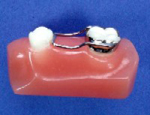
A band-and-loop maintainer is made of stainless steel wire and held in place by a crown or band on the tooth adjacent to the empty space. The wire is attached to the crown or loop and rests against the side of the tooth on the other end of the space.
Nance
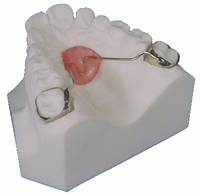
This appliance maintains the position of the maxillary molars without using any other teeth. The plastic button on the palate provides stability.
Lingual Arch
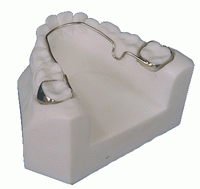
A lingual arch is used on the lower teeth when the back teeth on both sides of the jaw are lost. A wire is placed on the lingual (tongue) side of the arch and is attached to the tooth in front of the open space on both sides. This prevents the front teeth from shifting backwards into the gap.
Distal Shoe

In the case of a lost second primary molar prior to the eruption of the first permanent molar, a distal shoe may be recommended. Because the first permanent molar has not come in yet, there is no tooth to hold a band-and-loop space maintainer in place. A distal shoe appliance has a metal wire that is inserted slightly under the gum and will prevent the space from closing.
Palatal Expander
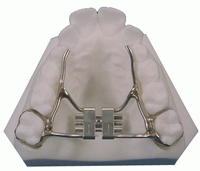
An appliance which is placed in the roof of the mouth to widen the upper dental arch. The maxilla, or upper dental arch, is joined in the center by a joint, which allows it to be painlessly separated and spread. Temporarily you may see a space develop between the upper two front teeth. This will slowly go away in a few days. Once this has occurred, the two halves knit back together and new bone fills in the space.
Quad Helix
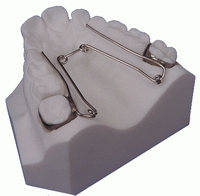
This appliance provides continual, gradual pressure in as many as four directions, to move molars, expand or contract arches or assist in eliminating finger or thumb habits.
Hawley
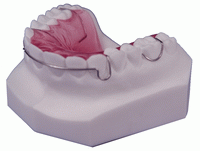
A universally used retainer with many applications; to move teeth, close spaces, maintain alignment during or after treatment.
Retainers
At the completion of the active phase of orthodontic treatment, braces are removed and removable appliances called retainers are placed. To retain means to hold. Teeth must be retained or held in their new positions while the tissues, meaning the bone, elastic membranes around the roots, the gums, tongue and lips have adapted themselves to the new tooth positions. Teeth can move if they are not retained. It is extremely important to wear your retainers as directed!
Caring for Your Child’s Space Maintainer
There are four general rules for taking care of your child’s appliance.
- Your child should avoid sticky foods, including candy and chewing gum.
- Encourage your child not to push or tug on the space maintainer with the fingers or tongue.
- Keep your child’s space maintainer clean through effective brushing and flossing.
- Your child should continue to see the pediatric dentist for regular dental visits.





 Website Powered by Sesame 24-7™
Website Powered by Sesame 24-7™